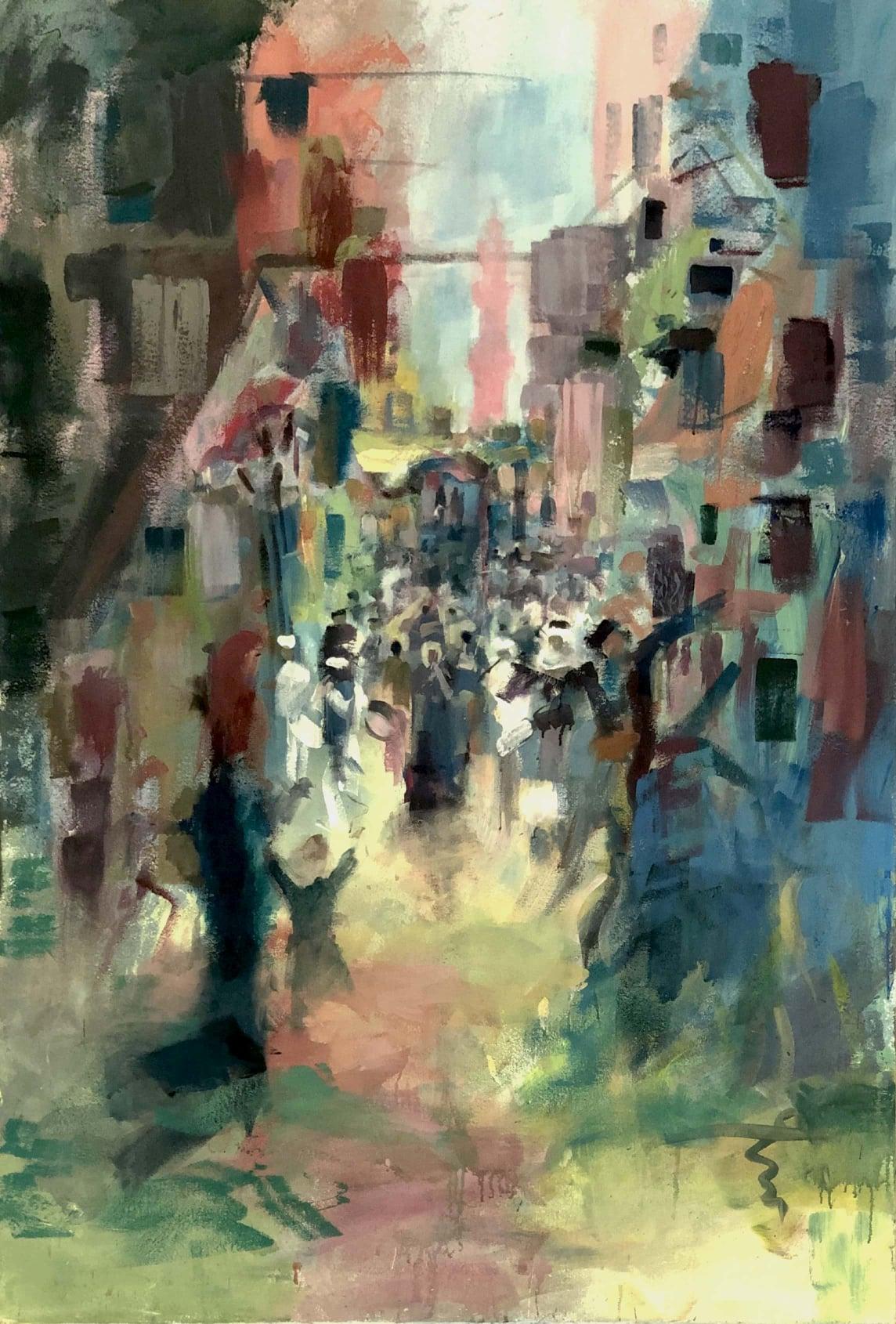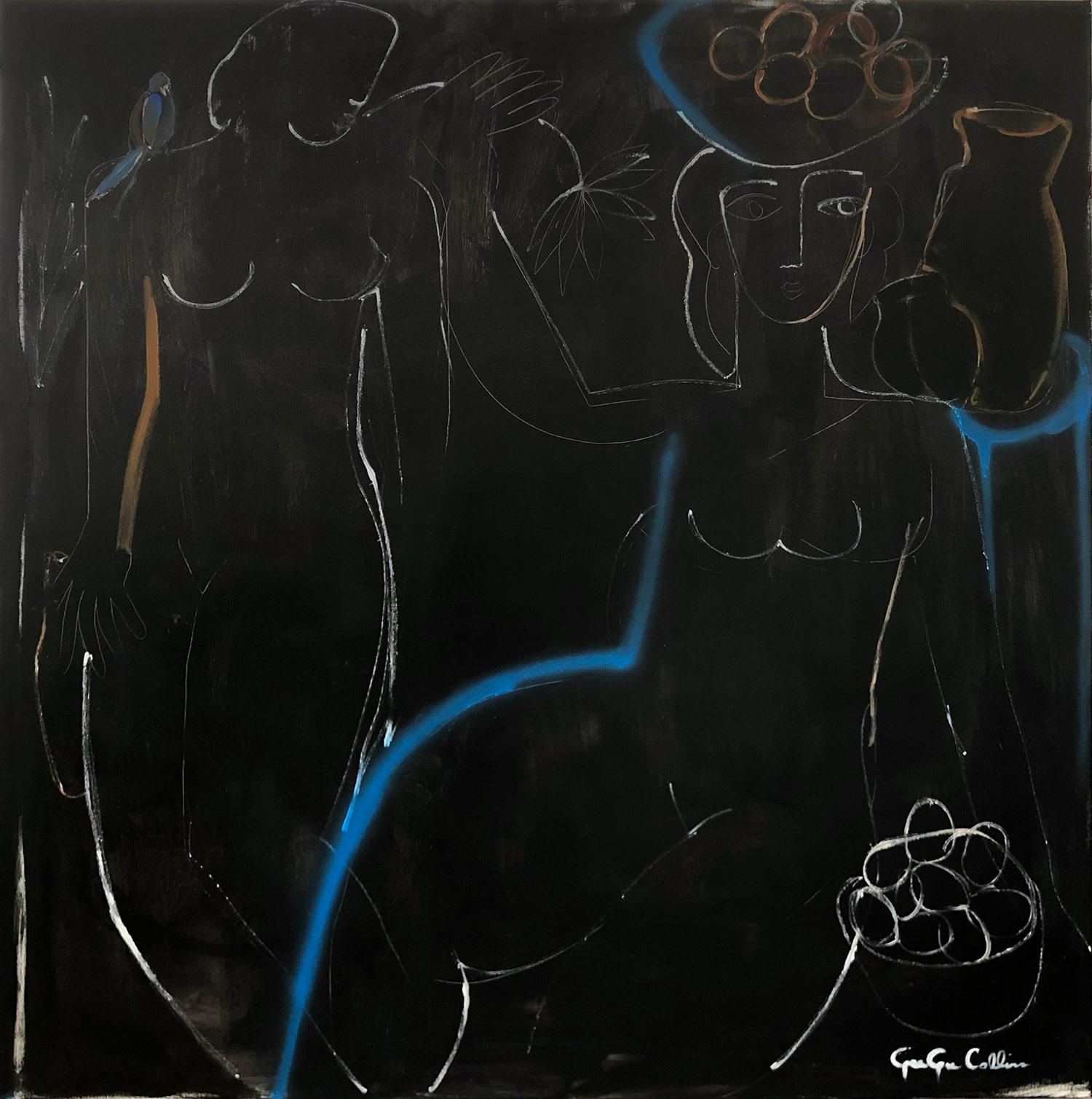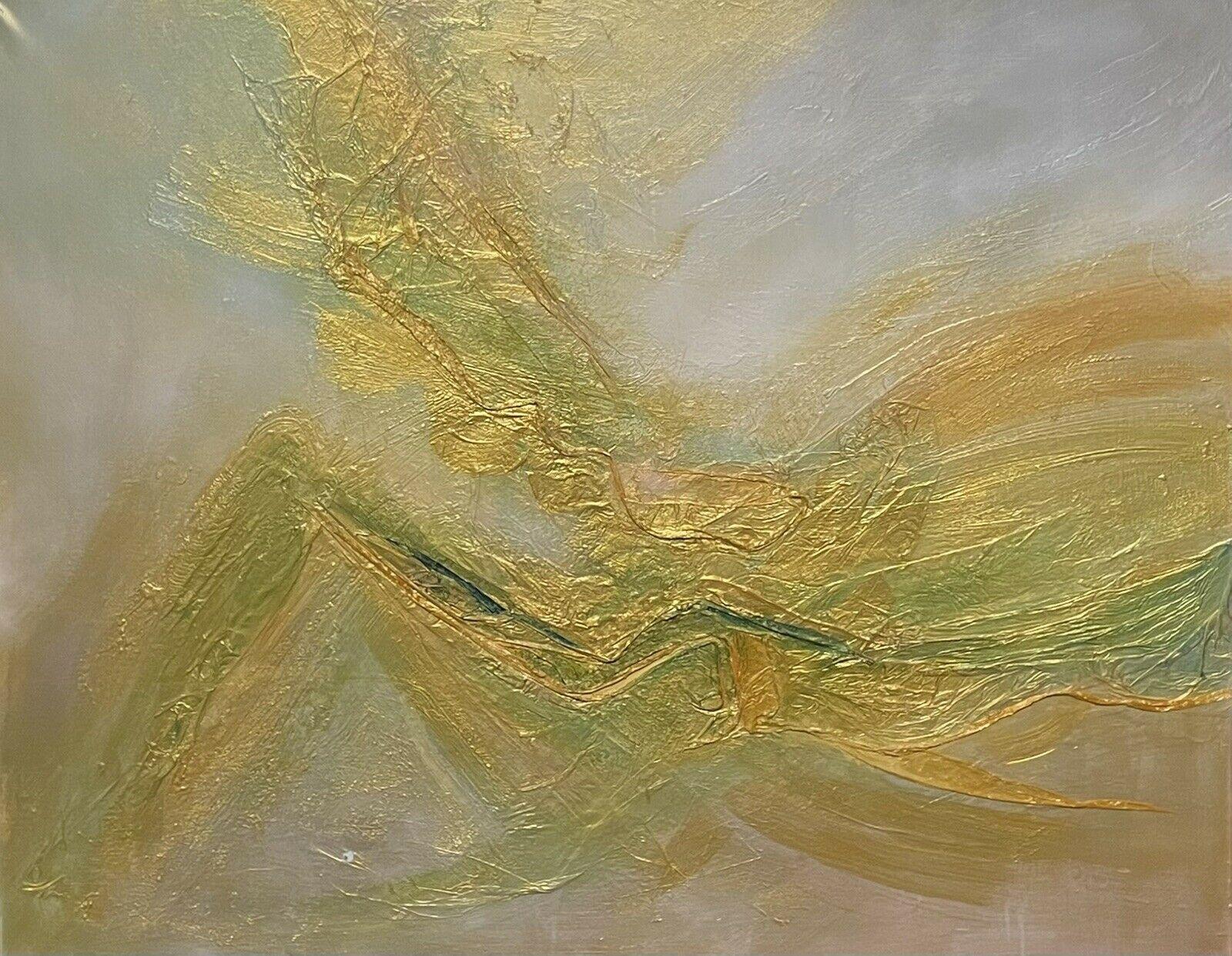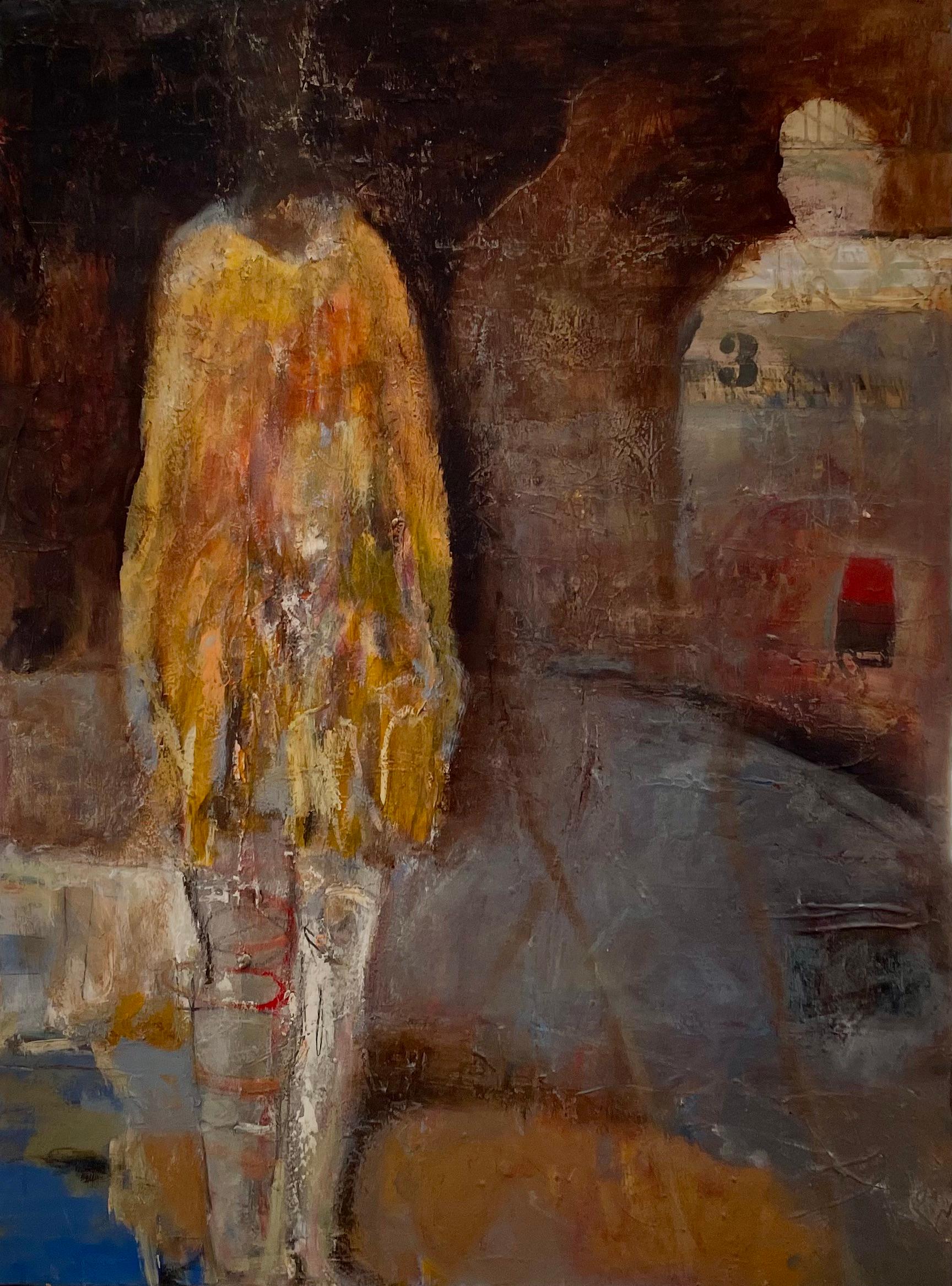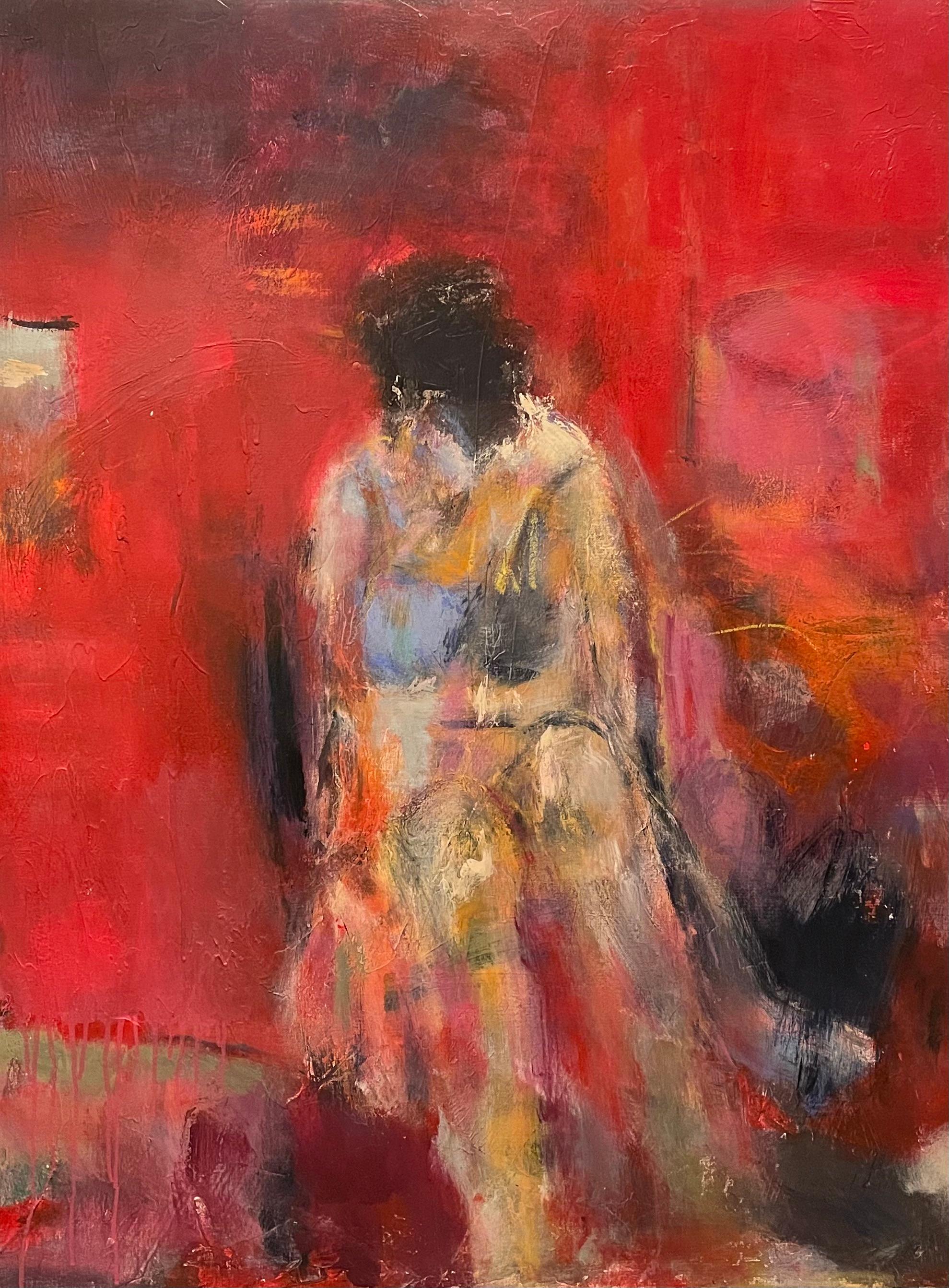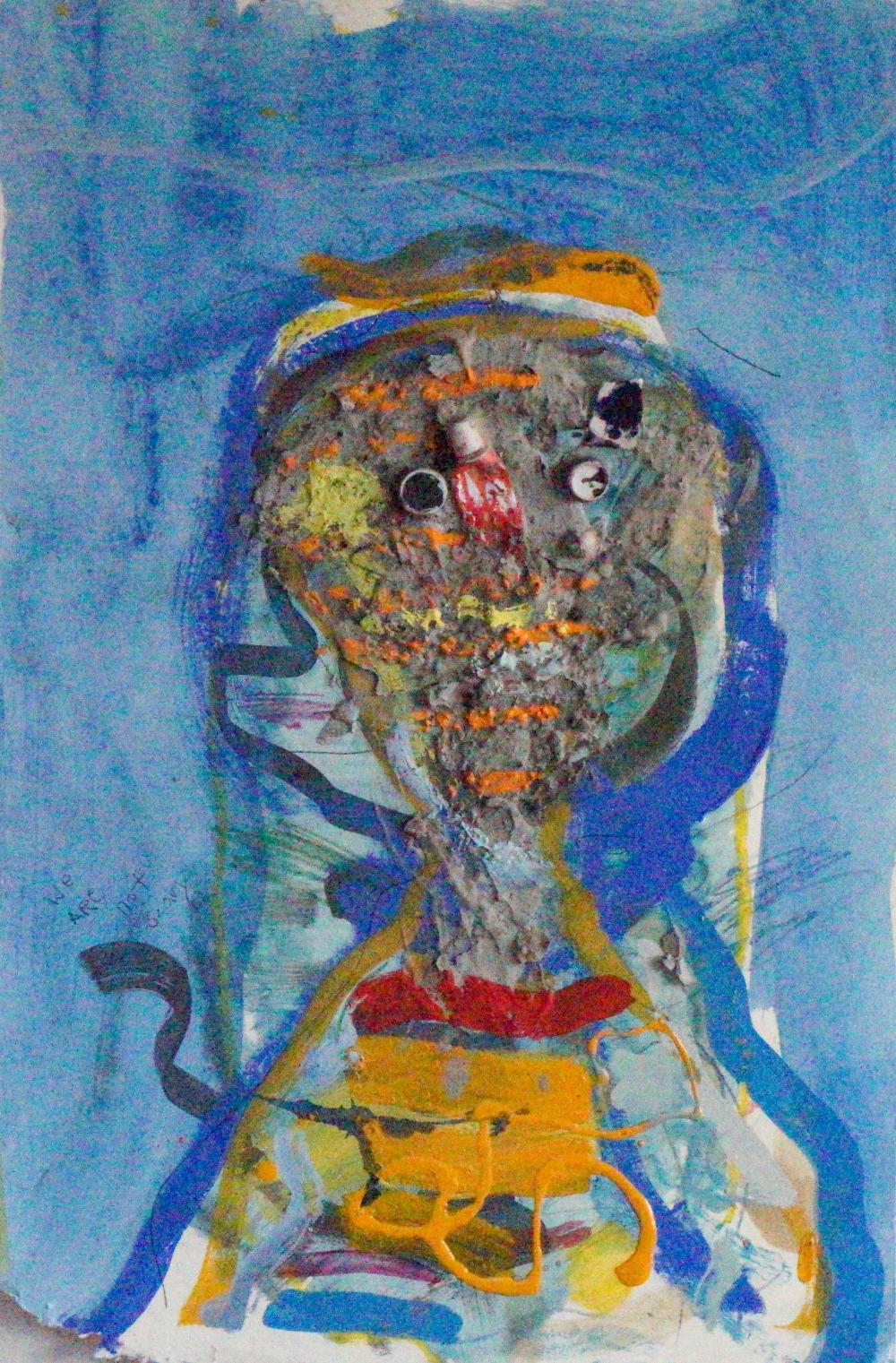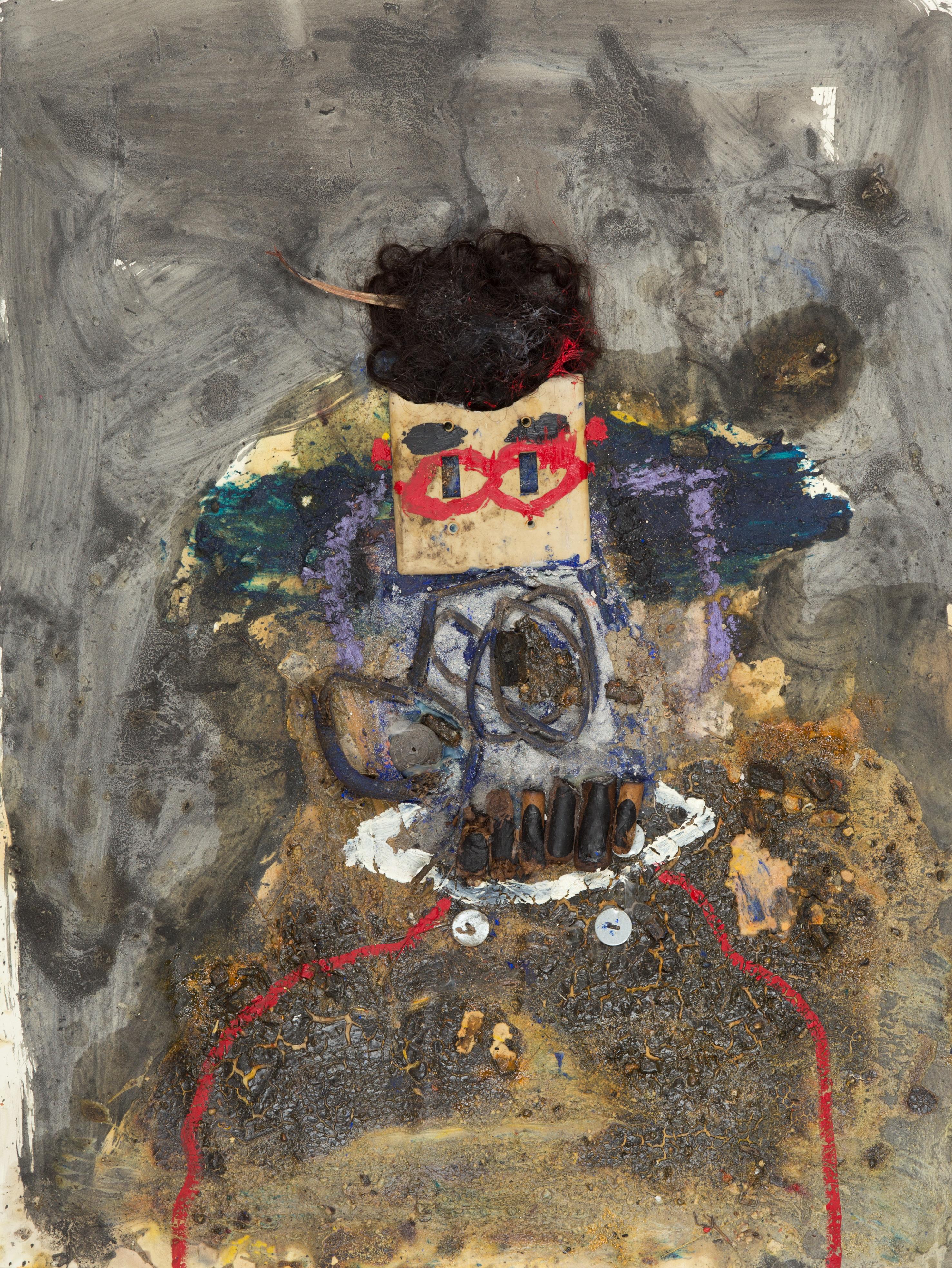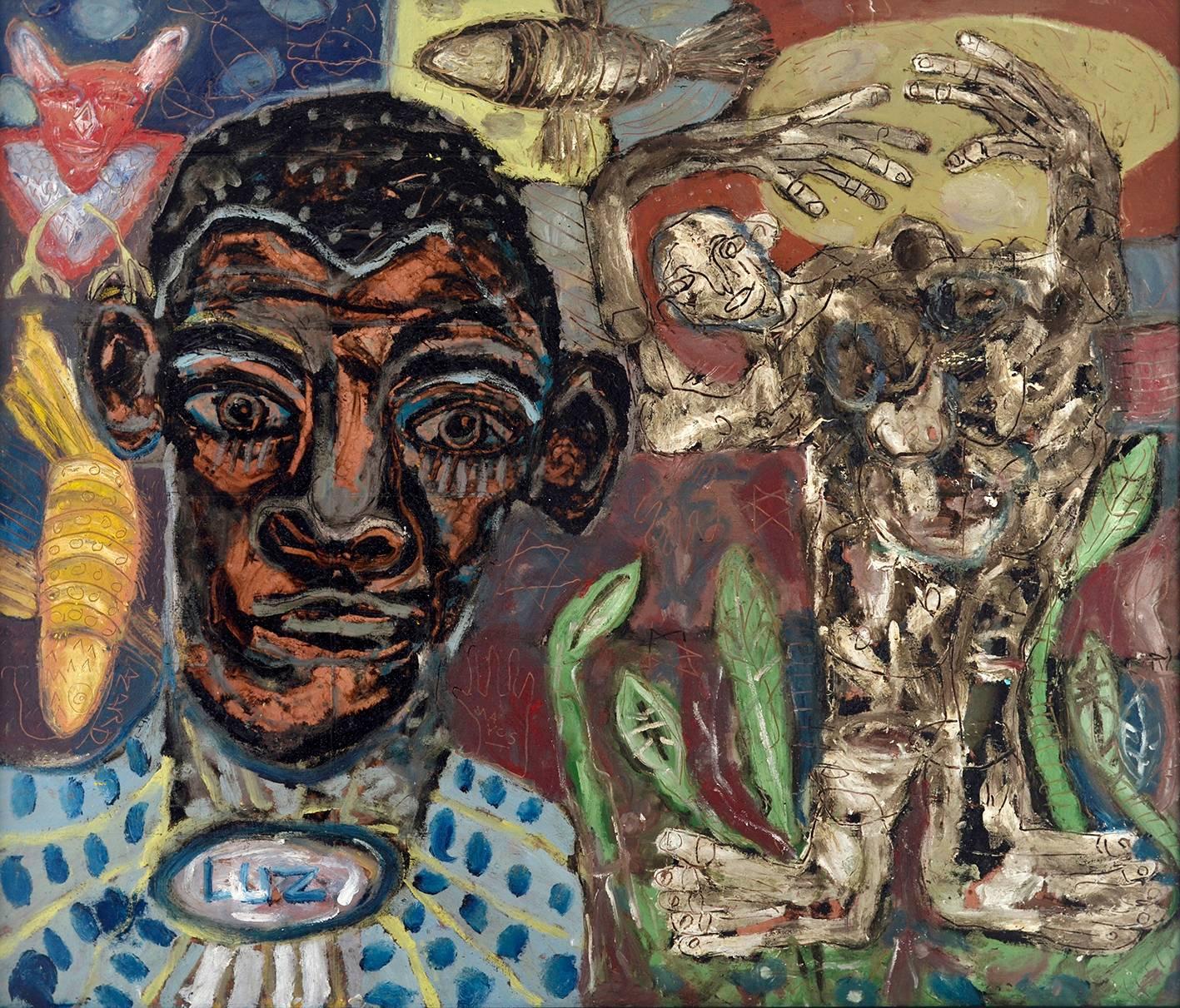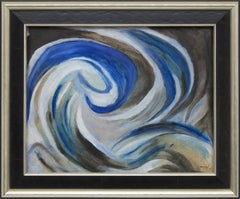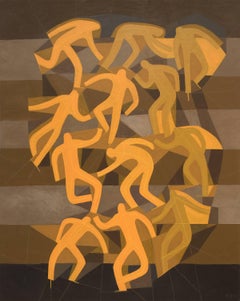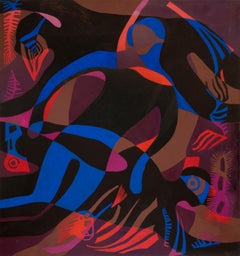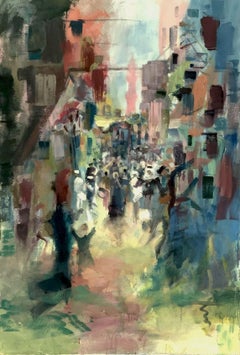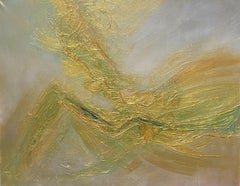
Action Series - Cycle
View Similar Items
Want more images or videos?
Request additional images or videos from the seller
1 of 9
Margo HoffAction Series - Cycle
About the Item
- Creator:Margo Hoff (1912, American)
- Dimensions:Height: 58 in (147.32 cm)Width: 46 in (116.84 cm)Depth: 1.25 in (3.18 cm)
- Medium:
- Movement & Style:
- Period:
- Condition:
- Gallery Location:Denver, CO
- Reference Number:Seller: 210131stDibs: LU2731190483
About the Seller
5.0
Platinum Seller
These expertly vetted sellers are 1stDibs' most experienced sellers and are rated highest by our customers.
Established in 1979
1stDibs seller since 2013
264 sales on 1stDibs
Typical response time: 3 hours
More From This SellerView All
- 1960s Abstract Oil Painting, Mid Century Modern Painting, Blue, White, GrayBy Charles Ragland BunnellLocated in Denver, COOriginal 1963 mid-century modern abstract oil painting by Colorado abstract expressionist painter, Charles Bunnell, painted in colors of blue, white,...Category
1960s Abstract Expressionist Abstract Paintings
MaterialsOil
- Skaters (Action Series), 1970s Figurative Abstract Collage Mixed Media PaintingBy Margo HoffLocated in Denver, COAcrylic, crayon, and paper mixed media collage on stretched canvas titled 'Skater' from the 'Action Series' signed by Margo Hoff (1910-2008). Featuring 12 figures in shades of yellow...Category
20th Century Abstract Abstract Paintings
MaterialsCrayon, Archival Paper, Acrylic, Mixed Media
- Dark Divers, Underwater Abstract Figurative Collage Painting, Blue Black, RedBy Margo HoffLocated in Denver, COMargo Hoff (1910-2008) original signed painting "Dark Divers" circa 1985, mixed media on canvas (acrylic, crayon, paper collage on stretched canvas) - 20th century Chicago woman artist. Wrapped canvas has finished edges and is ready for hanging. Provenance: Estate of the Artist, Margo Hoff Painting is clean and in very good condition - please contact us for a detailed condition report. A prolific artist, Margo Hoff’s exquisite style evolved throughout her career yet was always rooted in the events, people, and places in her life. The human experience was her sole focus, expressed through her eyes alone. Born in 1910 in Tulsa, Oklahoma, Hoff began creating white-clay animals at a young age, giving them to her friends and family. At eleven she contracted typhoid fever and was bedridden for a summer. During her convalescence, she drew and made cutouts, and it was during this time that her bold, artistic imagination came alive. She began formal art training in high school and continued her education at the University of Oklahoma, Tulsa. In 1933 she moved to Chicago and attended the National Academy of Art and the School of the Art Institute of Chicago. Between 1933 and 1960—her Chicago years—Hoff’s works was deeply rooted in a figurative, regionalist style. She often used elements of magical realism, and many of her paintings have dreamlike qualities. As a child she learned about color by grinding down rocks, plants, and berries. Her color pallet during the Chicago years is indicative of her early-life color experimentation as she consistently used warm, earth tones in her work. Hoff was a born adventurer and traveled extensively. She lived, worked, taught, and painted in Europe, Mexico, Lebanon, Uganda, Brazil, and China. She also showed at the Denver Art Museum’s Annual Western Exhibitions in 1952-54, 56, and 57. In 1957 she showed along side Colorado modernist Vance Kirkland at the Denver Art Museum’s exhibition, Man's Conquest of Space. What was once a focus on the representational, her work began to change after 1957 when she saw Sputnik in its orbit around Earth. At that moment, feet firmly placed on the ground, she was able to imagine herself in space, looking down from the cosmos, and what she saw was an abstracted world. She then had the opportunity to peer into an electron microscope where once again she was looking down into what seemed to be a realm of pure abstraction. These two events profoundly changed her perspective and she began to move from figural painting to abstract, geometric collage. In 1960, Hoff moved to New York City and she began creating collages. Placing the canvas on the ground, and working from all sides, she used strips of painted paper and tissue—and later painted pieces of canvas—glued onto the canvas surface, building layer upon layer, shape against shape, “action of color next to stillness of color.” She believed these simplified, abstracted forms held the spirit of the subject in the same way poetry reduces words to their essence. These pieces range from aerial cityscapes, to dancers in motions, to flora...Category
1980s Abstract Abstract Paintings
MaterialsMixed Media
- Break Dance, 1975 Large Abstract Figurative Collage Painting, Black Pink PurpleBy Margo HoffLocated in Denver, CO'Break Dancers' is an original vintage 1980s painting by Chicago artist, Margo Hoff (1910-2008). From the artist's "Action Series" the painting depicts ...Category
1970s Abstract Abstract Paintings
MaterialsCanvas, Mixed Media, Acrylic
- The Argument, 1960s Vintage Semi-Abstract Oil Painting in Reds, Pinks, and BlackBy Edward MarecakLocated in Denver, COOil on board painting by Edward Marecak (1919-1993) titled "The Argument" from 1968. Semi-abstract oil painting depicting two figures in colors of greens, pinks, blues, and blacks. Presented framed, outer dimensions measure 49 ½ x 33 ¼ x 1 ½ inches. Image size is 48 x 32 inches. Painting is clean and in very good vintage condition - please contact us for a detailed condition report. About the artist: Born to immigrant parents from the Carpathian region in Slovakia, Marecak grew up with his family in the farming community of Bennett’s Corners, now part of the town of Brunswick, near Cleveland, Ohio. When he turned twelve, his family moved to a multi-ethnic neighborhood of Poles, Czechs, Slovaks, and Slovenians in Cleveland. His childhood household cherished the customs and Slavic folk tales from the Old Country that later strongly influenced his work as a professional artist. During junior high he painted scenery for puppet shows of “Peter and the Wolf,” awakening his interest in art. In his senior year in high school he did Cézanne-inspired watercolors of Ohio barns at seventy-five cents apiece for the National Youth Administration. They earned him a full scholarship to the Cleveland Institute of Art (1938-1942) where he studied with Henry George Keller whose work was included in the 1913 New York Armory Show. In 1940 Marecak also taught at the Museum School of the Cleveland Institute. Before being drafted into the military in 1942, he briefly attended the Cranbrook Academy of Art near Detroit, one of the nation’s leading graduate schools of art, architecture, and design. A center of innovative work in architecture, art and design with an educational approach built on a mentorship model, it has been home to some of the world’s most renowned designers and artists, including Eero Saarinen, Charles Eames, Daniel Libeskind and Harry Bertoia. Marecak’s studies at Cranbrook with painter Zoltan Sepeshy and sculptor Carl Milles were interrupted by U.S. army service in the Aleutian Islands during World War II. Following his military discharge, Marecak studied on the G.I. Bill at the Colorado Springs Fine Arts Center from 1946 to 1950, having previously met its director, Boardman Robinson, conducting a seminar in mural painting at the Cleveland Institute of Art. Although he did not work with Robinson at the Fine Arts Center, who had become quite ill - retiring in 1947 - he studied Robinson’s specialty of mural painting before leaving to briefly attend the Cranbrook Academy in 1947. That same year he returned to the Fine Arts Center, studying painting with Jean Charlot and Mary Chenoweth, and lithography with Lawrence Barrett with whom he produced some 132 images during 1948-49. At the Fine Arts Center he met his future wife, Donna Fortin, whom he married in 1947. Also a Midwesterner, she had taken night art courses at Hull House in Chicago, later studying at the Art Institute of Chicago with the encouragement of artist Edgar Britton. After World War II she studied with him from 1946 to 1949 at the Fine Arts Center. (He had moved to Colorado Springs to treat his tuberculosis.) Ed Marecak also became good friends with Britton, later collaborating with him on the design of large stained glass windows for a local church. In 1950-51 Marecak returned to the Cleveland Institute of Art to complete his Bachelor of Fine Arts degree. A year later he was invited to conduct a summer class at the University of Colorado in Boulder, confirming his interest in the teaching profession. In 1955 he received his teaching certificate from the University of Denver. Vance Kirkland, the head of its art department, helped him get a teaching job with the Denver Public Schools so that he and his family could remain in the Mile High City. For the next twenty-five years he taught art at Skinner, Grove, East, George Washington and Morey Junior High Schools. Prior to coming to Colorado, Marecak did watercolors resembling those of Winslow Homer, John Singer Sargent and Charles Burchfield. However, once in Colorado Springs he decided to destroy much of his earlier oeuvre, embarking on a totally new direction unlike anything he had previously done. Initially, in the 1940s, he was influenced by surrealist imagery and Paul Klee and in the West by Indian petroglyphs and Kachinas. His first one-person show at the Garrett Gallery in Colorado Springs in 1949 featured paintings and lithographs rendered in the style of Magic Realism and referential abstraction. The pieces, including an oil Witch with Pink Dish...Category
1960s Abstract Abstract Paintings
MaterialsOil
- Winter Witches in an Upside World Interfering with Each Other, Semi-Abstract OilBy Edward MarecakLocated in Denver, COOil painting on burlap by Edward Marecak (1919-1993) titled "Winter Witches in an Upside World Interfering with Each Other" from 1990. Titled and dated by the artist on verso. Painted in shades of black, gray, red, purple, and green. Presented in the original artist frame, outer dimensions measure 44 ⅛ x 44 ⅛ x 1 ⅜ inches. Image size is 43 x 43 inches. About the artist: Edward Marecak Born Ohio 1919 Died Colorado 1993 Born to immigrant parents from the Carpathian region in Slovakia, Marecak grew up with his family in the farming community of Bennett’s Corners, now part of the town of Brunswick, near Cleveland, Ohio. When he turned twelve, his family moved to a multi-ethnic neighborhood of Poles, Czechs, Slovaks, and Slovenians in Cleveland. His childhood household cherished the customs and Slavic folk tales from the Old Country that later strongly influenced his work as a professional artist. During junior high he painted scenery for puppet shows of “Peter and the Wolf,” awakening his interest in art. In his senior year in high school he did Cézanne-inspired watercolors of Ohio barns at seventy-five cents apiece for the National Youth Administration. They earned him a full scholarship to the Cleveland Institute of Art (1938-1942) where he studied with Henry George Keller whose work was included in the 1913 New York Armory Show. In 1940 Marecak also taught at the Museum School of the Cleveland Institute. Before being drafted into the military in 1942, he briefly attended the Cranbrook Academy of Art near Detroit, one of the nation’s leading graduate schools of art, architecture, and design. A center of innovative work in architecture, art and design with an educational approach built on a mentorship model, it has been home to some of the world’s most renowned designers and artists, including Eero Saarinen, Charles Eames, Daniel Libeskind and Harry Bertoia. Marecak’s studies at Cranbrook with painter Zoltan Sepeshy and sculptor Carl Milles were interrupted by U.S. army service in the Aleutian Islands during World War II. Following his military discharge, Marecak studied on the G.I. Bill at the Colorado Springs Fine Arts Center from 1946 to 1950, having previously met its director, Boardman Robinson, conducting a seminar in mural painting at the Cleveland Institute of Art. Although he did not work with Robinson at the Fine Arts Center, who had become quite ill - retiring in 1947 - he studied Robinson’s specialty of mural painting before leaving to briefly attend the Cranbrook Academy in 1947. That same year he returned to the Fine Arts Center, studying painting with Jean Charlot and Mary Chenoweth, and lithography with Lawrence Barrett with whom he produced some 132 images during 1948-49. At the Fine Arts Center he met his future wife, Donna Fortin, whom he married in 1947. Also a Midwesterner, she had taken night art courses at Hull House in Chicago, later studying at the Art Institute of Chicago with the encouragement of artist Edgar Britton. After World War II she studied with him from 1946 to 1949 at the Fine Arts Center. (He had moved to Colorado Springs to treat his tuberculosis.) Ed Marecak also became good friends with Britton, later collaborating with him on the design of large stained glass windows for a local church. In 1950-51 Marecak returned to the Cleveland Institute of Art to complete his Bachelor of Fine Arts degree. A year later he was invited to conduct a summer class at the University of Colorado in Boulder, confirming his interest in the teaching profession. In 1955 he received his teaching certificate from the University of Denver. Vance Kirkland, the head of its art department, helped him get a teaching job with the Denver Public Schools so that he and his family could remain in the Mile High City. For the next twenty-five years he taught art at Skinner, Grove, East, George Washington and Morey Junior High Schools. Prior to coming to Colorado, Marecak did watercolors resembling those of Winslow Homer, John Singer Sargent and Charles Burchfield. However, once in Colorado Springs he decided to destroy much of his earlier oeuvre, embarking on a totally new direction unlike anything he had previously done. Initially, in the 1940s, he was influenced by surrealist imagery and Paul Klee and in the West by Indian petroglyphs and Kachinas. His first one-person show at the Garrett Gallery in Colorado Springs in 1949 featured paintings and lithographs rendered in the style of Magic Realism and referential abstraction. The pieces, including an oil Witch with Pink Dish, foreshadowed the output of his entire Colorado-based career, distinguished by a dramatic use of color, intricacy of execution and attention to detail contributing to their visual impact. He once observed, “Each time I start a new painting I always fool myself by saying this time keep it simple and not get entangled with such complex patterns, color and design; but I always find myself getting more involved with richness, color and subject matter.” An idiosyncratic artist proficient in oil, acrylic, watercolor, gouache, and casein, he did not draw upon Colorado subject matter for his work, unlike many of his fellow painters in the state. Instead he used Midwest landscape imagery, bringing to life in it witches and spirits adapted from the Slovakian folk tales he heard growing up in Ohio. A number of his paintings depict winter witches derived from the Slovak custom in the Tatra Mountains of burning an effigy of the winter witch in the early spring to banish the memory of a hard winter. The folk tale element imparts a dream-like quality to many of his paintings. A devote of Greek mythology, he placed the figures of Circe, Persephone, Sybil, Hera and others in modern settings. The goddess in Persephone Brings a Pumpkin to her Mother, attired as a Midwestern farmer’s daughter, heralds the advent of fall with the pumpkin before departing to spend the winter season in the underworld. Train to Olympus, the meeting place of the gods in ancient Greece, juxtaposes ancient mythology with modernity creating a combination of whimsy and thought-provoking consideration for the viewer. Voyage to Troy #1 alludes to the ancient city that was the site of the Trojan Wars, but has a contemporary, autobiographical component referencing the harbor of the Aleutian Islands recaptured from the Japanese during World War II. In the 1980s Marecak used the goddess Hera in his painting, Hera Contemplates Aspects of the Art Nouveau, to comment on art movements in the latter half of the twentieth century Marecak’s love of classical music and opera, which he shared with his wife and to which he often listened while painting in his Denver basement studio, is reflected in Homage of Offenbach, an abstract work translating the composer’s musical colors into colorful palette. Pace, Pace, Mio Dio, the title of his earliest surrealist painting, is a soprano aria from Verdi’s opera...Category
1990s Abstract Figurative Paintings
MaterialsBurlap, Oil
You May Also Like
- "Untitled 120" Abstract Painting 71" x 47" inch by Ahmed DafrawyBy Ahmed DafrawyLocated in Culver City, CA"Untitled 120" Abstract Painting 71" x 47" inch by Ahmed Dafrawy * Due to the Ministry of Culture policy + COVID situation, handling time (paperwork) m...Category
21st Century and Contemporary Abstract Expressionist Abstract Paintings
MaterialsCanvas, Mixed Media
- "Blue Line + Fruit" Modernist Black and White Abstract Nudes Painting on CanvasBy Gee Gee CollinsLocated in New York, NYA modernist depiction of figures executed with strong use of line and texture. This piece is filled with movement and beautiful brushwork, the use of color placement is enchanting wi...Category
2010s Abstract Expressionist Figurative Paintings
MaterialsCanvas, Mixed Media, Acrylic
- French Contemporary Abstract Painting Gold Highlights Expressionist CompositionLocated in Cirencester, GloucestershireArtist/ School: French expressionist/ abstract contemporary artist, 21st century Title: Abstract composition Medium: oil/mixed media painting on canvas, unframed. canvas: 25.75...Category
21st Century and Contemporary Abstract Expressionist Abstract Paintings
MaterialsOil, Canvas, Mixed Media
- "Untitled 98" Abstract Painting 79" x 55" inch by Ahmed DafrawyBy Ahmed DafrawyLocated in Culver City, CA"Untitled 98" Abstract Painting 79" x 55" inch by Ahmed Dafrawy * Due to the Ministry of Culture policy + COVID situation, handling time (paperwork) ma...Category
21st Century and Contemporary Abstract Expressionist Abstract Paintings
MaterialsMixed Media, Canvas
- "In Passing" Contemporary Figurative Abstract ExpressionistBy Helen SteeleLocated in Carmel, CA"In Passing," a 48" x 24" work by Helen Steele, is a contemplative piece that captures the ephemeral nature of human presence through the lens of contemporary figurative abstraction....Category
21st Century and Contemporary Abstract Expressionist Figurative Paintings
MaterialsCanvas, Mixed Media
$10,000 Sale Price31% Off - "Lost" Mixed Media Contemporary Figurative Abstract ExpressionistBy Helen SteeleLocated in Carmel, CA"Lost" by Helen Steele is a 48" x 36" mixed media canvas that resonates with the poignant solitude of contemporary figurative abstraction. Dark, brooding browns and deep shadows form...Category
21st Century and Contemporary Abstract Expressionist Figurative Paintings
MaterialsCanvas, Mixed Media
$12,000 Sale Price20% Off
